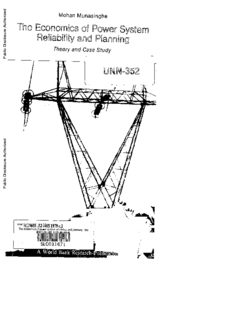
Theory and Case Study PDF
Preview Theory and Case Study
dd ee Mohan Munasinghe zz riri oo hh utut The Economics of Power System AA e e urur Reliability and Planning ss oo clcl ss DiDi Theory and Case Study c c blibli uu PP dd ee zz riri oo hh utut AA e e rr uu ss oo clcl ss DiDi c c blibli uu PP dd ee zz riri oo hh utut AA e e rr uu ss oo clcl ss DiDi c c blibli uu PP '~~~~~~~~~~~~~~~' dd ee zz riri oo hh utut HD9685 .A2 M8S 1979 c.2 AA The economics or power system reliabIl-y anid planning -the A e e rr uu ss oo sclscl SLC031671 DiDi A o.3 - c c blibli uu PP PRCP<,1e V ENttERGY LIBRARY 1. B. R. D I M?5 lqe9 The Economics of Power System Reliability and Planning SECTORAL LIBRARY INUERNATIONAL BANK RECONSRI RUCrON AND DFVFLOPMENrF SEP 0 3 1987 37N E ER G Y LlBRRY AW a A World Bank Research Publication Mohan Munasinghe The Economics of Power System Reliability and Planning Theory and Case Study SECTORAL LIBRARY INTERNArIONAL BANK FOR RECONSTRUC7ION AND DFVE[OPMENM with contributions by SEP O 3 1987 Walter G. Scott and Mark Gellerson Published for the World Bank The Johns Hopkins University Press Baltimore and London Copyright © 1979 by the International Bank for Reconstruction and Development / The World Bank 1818 H Street, N.W., Washington, D.C. 20433, U.S.A. All rights reserved Manufactured in the United States of America The views and interpretations in this book are the author's and should not be attributed to the World Bank, to its affiliated organizations, or to any individual acting in their behalf. Library of Congress Cataloging in Publication Data Munasinghe, Mohan. The economics of power system reliability and planning. Bibliography: p. 306. 1. Electric power systems-Reliability-Economic aspects. 2. Underdeveloped areas-Electric utilities- Case studies. 1. Scott, Walter G. II. Gellerson, Mark. III. Title. HD9685.A2M85 338.4'3 79-2182 ISBN 0-8018-2276-9 ISBN 0-8018-2277-7 PBK. Foreword In evaluating the merits of the investment programs it finances, the World Bank has generally sought to adopt a national viewpoint, by con- sidering not only the supply costs incurred by the borrowing institution, but also the effect of these investments on other individuals and enter- prises in the economy. In view of the increasing dependence of modern economies on electric power, the capital-intensive nature of the power sector, and the shortage of economic resources in the developing coun- tries, the Bank's wider concerns have focused on, among other things, the trade-off between the rising unit costs of electricity supply and the costs imposed on consumers by the reduced reliability or quality of supply. I believe that this is the first book that seeks to provide a well- balanced and integrated economic-engineering treatment of the topic of power system reliability. It demonstrates that in order to maximize the net social benefit of consuming electric power, it is necessary to mini- mize total social costs, which consist of both the supply costs to the power authority and the costs to the consumer that are likely to result from supply shortages or power outages. This approach, which estab- lishes socially optimum reliability levels, subsumes the traditional sys- tem planning criterion based upon minimization of system costs alone. Thus the methodology presented here is both timely and relevant, not only in the Third World, but also in the developed countries. v Vi FOREWORD This book is an integral part of the World Bank's continuing research program in energy, and as such it is linked to and contributes to other elements in the overall research effort. Thus, the book analyzes the sub- ject of optimum system reliability within a broader context by discussing a range of related topics that are of more general application, including demand forecasting, system expansion planning, shadow pricing, and optimum tariff policy. YVES ROVANI Director Energy Department The World Bank Contents Foreword v Figures xi Tables xiii Preface xv Definitions xix Part One. Theory 1 Chapter 1. Objectives and Methodology 3 Summary of Methodology and Conclusions 5 Chapter 2. Introduction to Reliability 9 Reliability Concepts 9 Measures of Reliability 16 The Need for Economic Criteria 24 Chapter3 . Method of Optimizing Reliability 28 Features of the Model 28 Reliability Optimizing Planning Model 33 Outage Simulations and Optimum Reliability Levels 37 vii Viii CONTENTS Chapter 4. Estimation of Outage Costs (with Mark Gellerson) 45 Nature of Outage Costs 45 Methods of Estimating Outage Costs 49 Review of Previous Studies 54 Measurement of outage costs 55 Treatment of electricity consumers by category 58 Relation between outage costs and outage duration 60 Conclusion 61 Chapter5 . Residential Outage Costs 62 Household Activities 63 Value of Foregone Leisure 65 Empirical Estimation 69 Chapter 6. IndustrialO utage Costs 72 Types of Outage Costs 72 Spoiled Product Cost 74 Idle Factor Cost 75 Overtime Production Cost 77 Chapter 7. Other Outage Costs 80 Commercial 80 Public Services 82 Special Institutions 83 Rural 85 Secondary Effects 85 Chapter 8. Power System Planning and Supply Costs 87 The Investment Decision 87 Load Forecast 89 System Design and Planning 94 Costing 102 Chapter9 . Shadow Pricing 105 General Principles 105 Numeraire 109 Application of Shadow Prices 110
Description: